An Economic Analysis of the Gender Wage Gap in Labor Markets
VerifiedAdded on 2022/08/29
|5
|1649
|12
Essay
AI Summary
This essay delves into the pervasive issue of the gender wage gap in labor markets, examining the disparities in pay between men and women. It highlights the various factors contributing to this inequality, including the influence of male-dominated societies, the underrepresentation of women in senior roles, and the tendency for women to choose lower-paying positions. The essay also explores the concept of the gender fee gap, which further exacerbates the issue. The essay further discusses the impact of societal expectations, such as the expectation for women to balance work and family responsibilities, which can lead to career interruptions and reduced earning potential. It also mentions that women often face discrimination in hiring and promotion. The essay concludes by advocating for solutions such as women demanding equal pay, challenging male-dominated cultures, and judging individuals based on skills rather than gender, and the need for labor markets to control fee ratios. The essay offers a comprehensive overview of the gender wage gap, its causes, and potential solutions, highlighting the need for societal and economic changes to achieve pay equality.
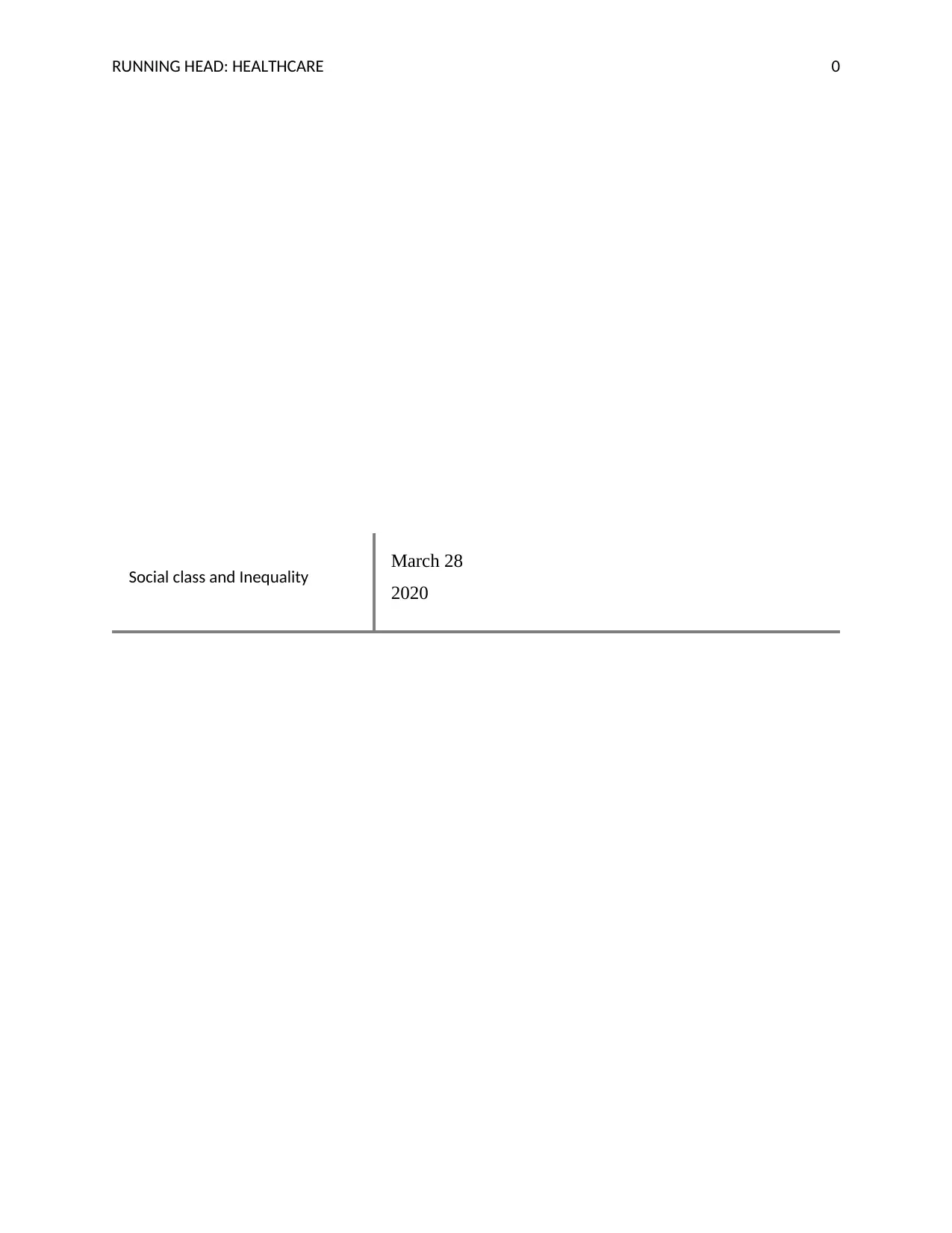
RUNNING HEAD: HEALTHCARE 0
Social class and Inequality March 28
2020
Social class and Inequality March 28
2020
Paraphrase This Document
Need a fresh take? Get an instant paraphrase of this document with our AI Paraphraser
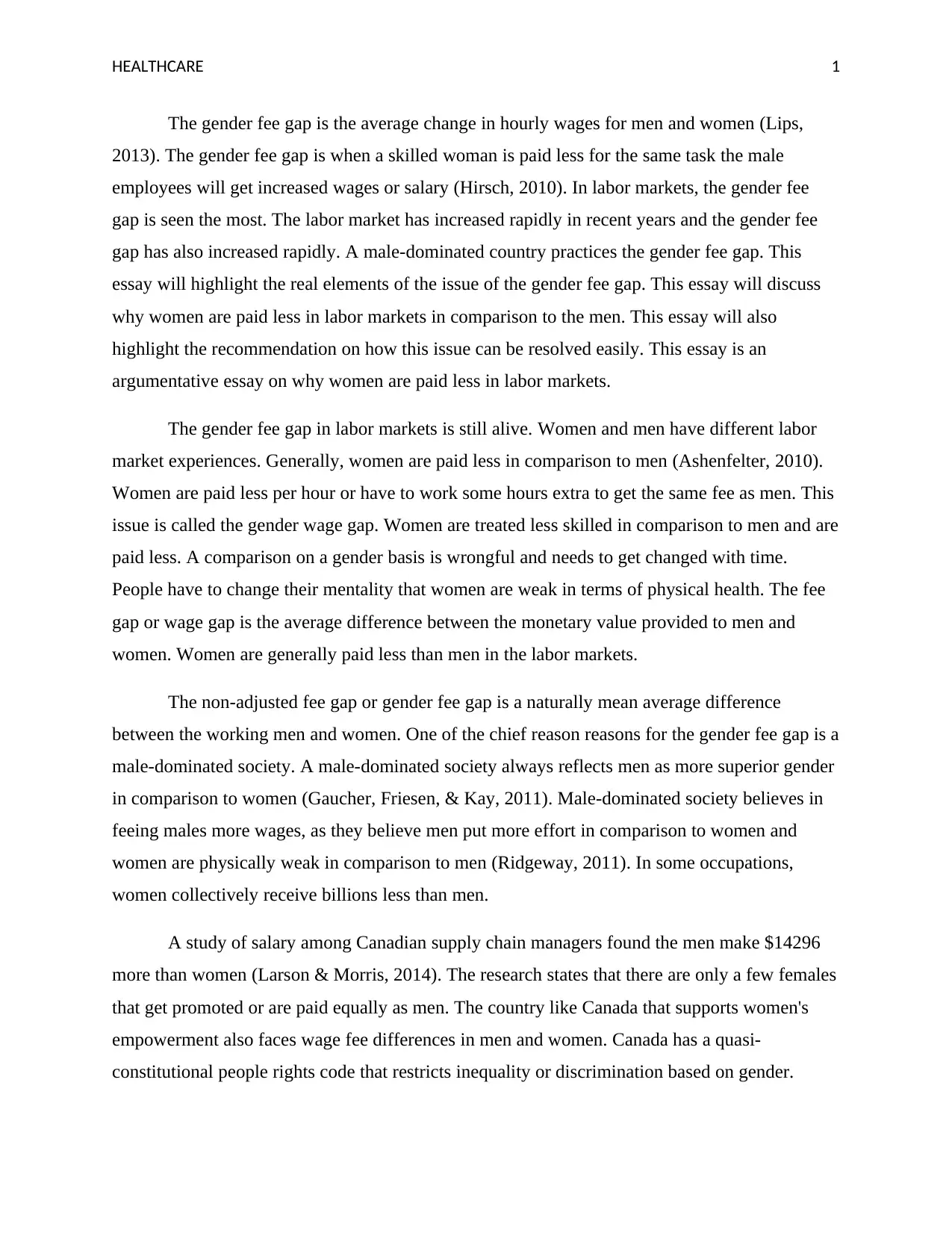
HEALTHCARE 1
The gender fee gap is the average change in hourly wages for men and women (Lips,
2013). The gender fee gap is when a skilled woman is paid less for the same task the male
employees will get increased wages or salary (Hirsch, 2010). In labor markets, the gender fee
gap is seen the most. The labor market has increased rapidly in recent years and the gender fee
gap has also increased rapidly. A male-dominated country practices the gender fee gap. This
essay will highlight the real elements of the issue of the gender fee gap. This essay will discuss
why women are paid less in labor markets in comparison to the men. This essay will also
highlight the recommendation on how this issue can be resolved easily. This essay is an
argumentative essay on why women are paid less in labor markets.
The gender fee gap in labor markets is still alive. Women and men have different labor
market experiences. Generally, women are paid less in comparison to men (Ashenfelter, 2010).
Women are paid less per hour or have to work some hours extra to get the same fee as men. This
issue is called the gender wage gap. Women are treated less skilled in comparison to men and are
paid less. A comparison on a gender basis is wrongful and needs to get changed with time.
People have to change their mentality that women are weak in terms of physical health. The fee
gap or wage gap is the average difference between the monetary value provided to men and
women. Women are generally paid less than men in the labor markets.
The non-adjusted fee gap or gender fee gap is a naturally mean average difference
between the working men and women. One of the chief reason reasons for the gender fee gap is a
male-dominated society. A male-dominated society always reflects men as more superior gender
in comparison to women (Gaucher, Friesen, & Kay, 2011). Male-dominated society believes in
feeing males more wages, as they believe men put more effort in comparison to women and
women are physically weak in comparison to men (Ridgeway, 2011). In some occupations,
women collectively receive billions less than men.
A study of salary among Canadian supply chain managers found the men make $14296
more than women (Larson & Morris, 2014). The research states that there are only a few females
that get promoted or are paid equally as men. The country like Canada that supports women's
empowerment also faces wage fee differences in men and women. Canada has a quasi-
constitutional people rights code that restricts inequality or discrimination based on gender.
The gender fee gap is the average change in hourly wages for men and women (Lips,
2013). The gender fee gap is when a skilled woman is paid less for the same task the male
employees will get increased wages or salary (Hirsch, 2010). In labor markets, the gender fee
gap is seen the most. The labor market has increased rapidly in recent years and the gender fee
gap has also increased rapidly. A male-dominated country practices the gender fee gap. This
essay will highlight the real elements of the issue of the gender fee gap. This essay will discuss
why women are paid less in labor markets in comparison to the men. This essay will also
highlight the recommendation on how this issue can be resolved easily. This essay is an
argumentative essay on why women are paid less in labor markets.
The gender fee gap in labor markets is still alive. Women and men have different labor
market experiences. Generally, women are paid less in comparison to men (Ashenfelter, 2010).
Women are paid less per hour or have to work some hours extra to get the same fee as men. This
issue is called the gender wage gap. Women are treated less skilled in comparison to men and are
paid less. A comparison on a gender basis is wrongful and needs to get changed with time.
People have to change their mentality that women are weak in terms of physical health. The fee
gap or wage gap is the average difference between the monetary value provided to men and
women. Women are generally paid less than men in the labor markets.
The non-adjusted fee gap or gender fee gap is a naturally mean average difference
between the working men and women. One of the chief reason reasons for the gender fee gap is a
male-dominated society. A male-dominated society always reflects men as more superior gender
in comparison to women (Gaucher, Friesen, & Kay, 2011). Male-dominated society believes in
feeing males more wages, as they believe men put more effort in comparison to women and
women are physically weak in comparison to men (Ridgeway, 2011). In some occupations,
women collectively receive billions less than men.
A study of salary among Canadian supply chain managers found the men make $14296
more than women (Larson & Morris, 2014). The research states that there are only a few females
that get promoted or are paid equally as men. The country like Canada that supports women's
empowerment also faces wage fee differences in men and women. Canada has a quasi-
constitutional people rights code that restricts inequality or discrimination based on gender.
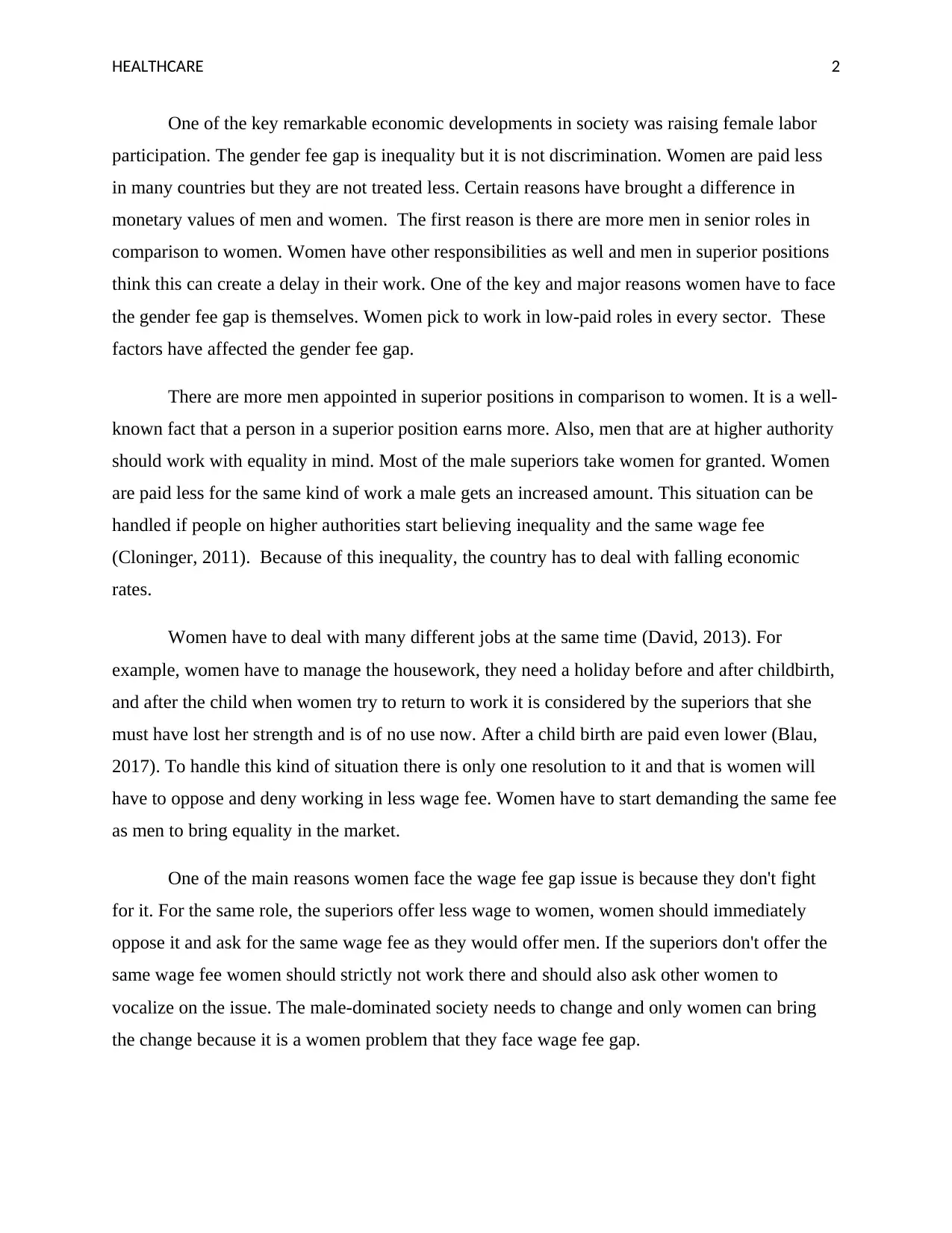
HEALTHCARE 2
One of the key remarkable economic developments in society was raising female labor
participation. The gender fee gap is inequality but it is not discrimination. Women are paid less
in many countries but they are not treated less. Certain reasons have brought a difference in
monetary values of men and women. The first reason is there are more men in senior roles in
comparison to women. Women have other responsibilities as well and men in superior positions
think this can create a delay in their work. One of the key and major reasons women have to face
the gender fee gap is themselves. Women pick to work in low-paid roles in every sector. These
factors have affected the gender fee gap.
There are more men appointed in superior positions in comparison to women. It is a well-
known fact that a person in a superior position earns more. Also, men that are at higher authority
should work with equality in mind. Most of the male superiors take women for granted. Women
are paid less for the same kind of work a male gets an increased amount. This situation can be
handled if people on higher authorities start believing inequality and the same wage fee
(Cloninger, 2011). Because of this inequality, the country has to deal with falling economic
rates.
Women have to deal with many different jobs at the same time (David, 2013). For
example, women have to manage the housework, they need a holiday before and after childbirth,
and after the child when women try to return to work it is considered by the superiors that she
must have lost her strength and is of no use now. After a child birth are paid even lower (Blau,
2017). To handle this kind of situation there is only one resolution to it and that is women will
have to oppose and deny working in less wage fee. Women have to start demanding the same fee
as men to bring equality in the market.
One of the main reasons women face the wage fee gap issue is because they don't fight
for it. For the same role, the superiors offer less wage to women, women should immediately
oppose it and ask for the same wage fee as they would offer men. If the superiors don't offer the
same wage fee women should strictly not work there and should also ask other women to
vocalize on the issue. The male-dominated society needs to change and only women can bring
the change because it is a women problem that they face wage fee gap.
One of the key remarkable economic developments in society was raising female labor
participation. The gender fee gap is inequality but it is not discrimination. Women are paid less
in many countries but they are not treated less. Certain reasons have brought a difference in
monetary values of men and women. The first reason is there are more men in senior roles in
comparison to women. Women have other responsibilities as well and men in superior positions
think this can create a delay in their work. One of the key and major reasons women have to face
the gender fee gap is themselves. Women pick to work in low-paid roles in every sector. These
factors have affected the gender fee gap.
There are more men appointed in superior positions in comparison to women. It is a well-
known fact that a person in a superior position earns more. Also, men that are at higher authority
should work with equality in mind. Most of the male superiors take women for granted. Women
are paid less for the same kind of work a male gets an increased amount. This situation can be
handled if people on higher authorities start believing inequality and the same wage fee
(Cloninger, 2011). Because of this inequality, the country has to deal with falling economic
rates.
Women have to deal with many different jobs at the same time (David, 2013). For
example, women have to manage the housework, they need a holiday before and after childbirth,
and after the child when women try to return to work it is considered by the superiors that she
must have lost her strength and is of no use now. After a child birth are paid even lower (Blau,
2017). To handle this kind of situation there is only one resolution to it and that is women will
have to oppose and deny working in less wage fee. Women have to start demanding the same fee
as men to bring equality in the market.
One of the main reasons women face the wage fee gap issue is because they don't fight
for it. For the same role, the superiors offer less wage to women, women should immediately
oppose it and ask for the same wage fee as they would offer men. If the superiors don't offer the
same wage fee women should strictly not work there and should also ask other women to
vocalize on the issue. The male-dominated society needs to change and only women can bring
the change because it is a women problem that they face wage fee gap.
⊘ This is a preview!⊘
Do you want full access?
Subscribe today to unlock all pages.

Trusted by 1+ million students worldwide
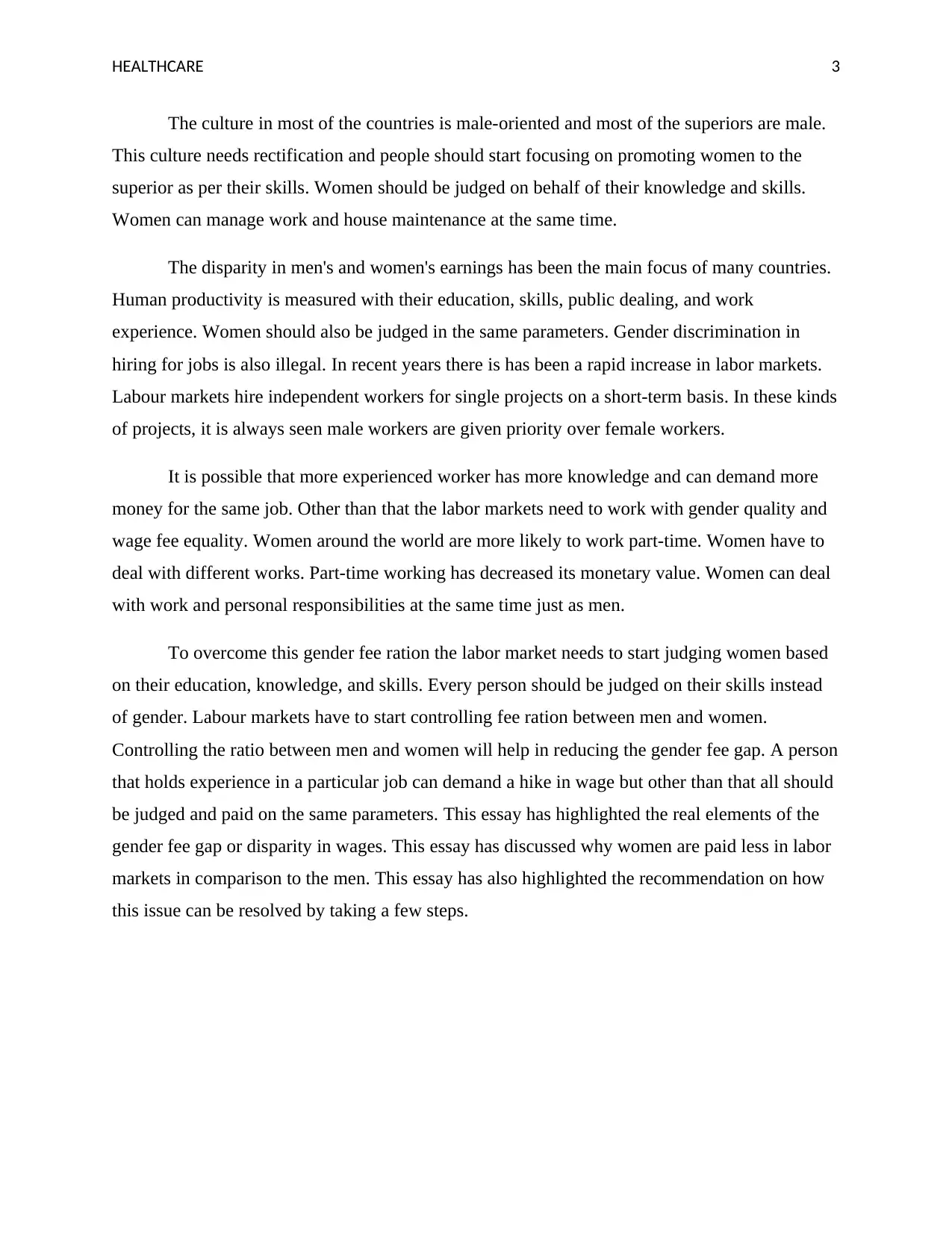
HEALTHCARE 3
The culture in most of the countries is male-oriented and most of the superiors are male.
This culture needs rectification and people should start focusing on promoting women to the
superior as per their skills. Women should be judged on behalf of their knowledge and skills.
Women can manage work and house maintenance at the same time.
The disparity in men's and women's earnings has been the main focus of many countries.
Human productivity is measured with their education, skills, public dealing, and work
experience. Women should also be judged in the same parameters. Gender discrimination in
hiring for jobs is also illegal. In recent years there is has been a rapid increase in labor markets.
Labour markets hire independent workers for single projects on a short-term basis. In these kinds
of projects, it is always seen male workers are given priority over female workers.
It is possible that more experienced worker has more knowledge and can demand more
money for the same job. Other than that the labor markets need to work with gender quality and
wage fee equality. Women around the world are more likely to work part-time. Women have to
deal with different works. Part-time working has decreased its monetary value. Women can deal
with work and personal responsibilities at the same time just as men.
To overcome this gender fee ration the labor market needs to start judging women based
on their education, knowledge, and skills. Every person should be judged on their skills instead
of gender. Labour markets have to start controlling fee ration between men and women.
Controlling the ratio between men and women will help in reducing the gender fee gap. A person
that holds experience in a particular job can demand a hike in wage but other than that all should
be judged and paid on the same parameters. This essay has highlighted the real elements of the
gender fee gap or disparity in wages. This essay has discussed why women are paid less in labor
markets in comparison to the men. This essay has also highlighted the recommendation on how
this issue can be resolved by taking a few steps.
The culture in most of the countries is male-oriented and most of the superiors are male.
This culture needs rectification and people should start focusing on promoting women to the
superior as per their skills. Women should be judged on behalf of their knowledge and skills.
Women can manage work and house maintenance at the same time.
The disparity in men's and women's earnings has been the main focus of many countries.
Human productivity is measured with their education, skills, public dealing, and work
experience. Women should also be judged in the same parameters. Gender discrimination in
hiring for jobs is also illegal. In recent years there is has been a rapid increase in labor markets.
Labour markets hire independent workers for single projects on a short-term basis. In these kinds
of projects, it is always seen male workers are given priority over female workers.
It is possible that more experienced worker has more knowledge and can demand more
money for the same job. Other than that the labor markets need to work with gender quality and
wage fee equality. Women around the world are more likely to work part-time. Women have to
deal with different works. Part-time working has decreased its monetary value. Women can deal
with work and personal responsibilities at the same time just as men.
To overcome this gender fee ration the labor market needs to start judging women based
on their education, knowledge, and skills. Every person should be judged on their skills instead
of gender. Labour markets have to start controlling fee ration between men and women.
Controlling the ratio between men and women will help in reducing the gender fee gap. A person
that holds experience in a particular job can demand a hike in wage but other than that all should
be judged and paid on the same parameters. This essay has highlighted the real elements of the
gender fee gap or disparity in wages. This essay has discussed why women are paid less in labor
markets in comparison to the men. This essay has also highlighted the recommendation on how
this issue can be resolved by taking a few steps.
Paraphrase This Document
Need a fresh take? Get an instant paraphrase of this document with our AI Paraphraser
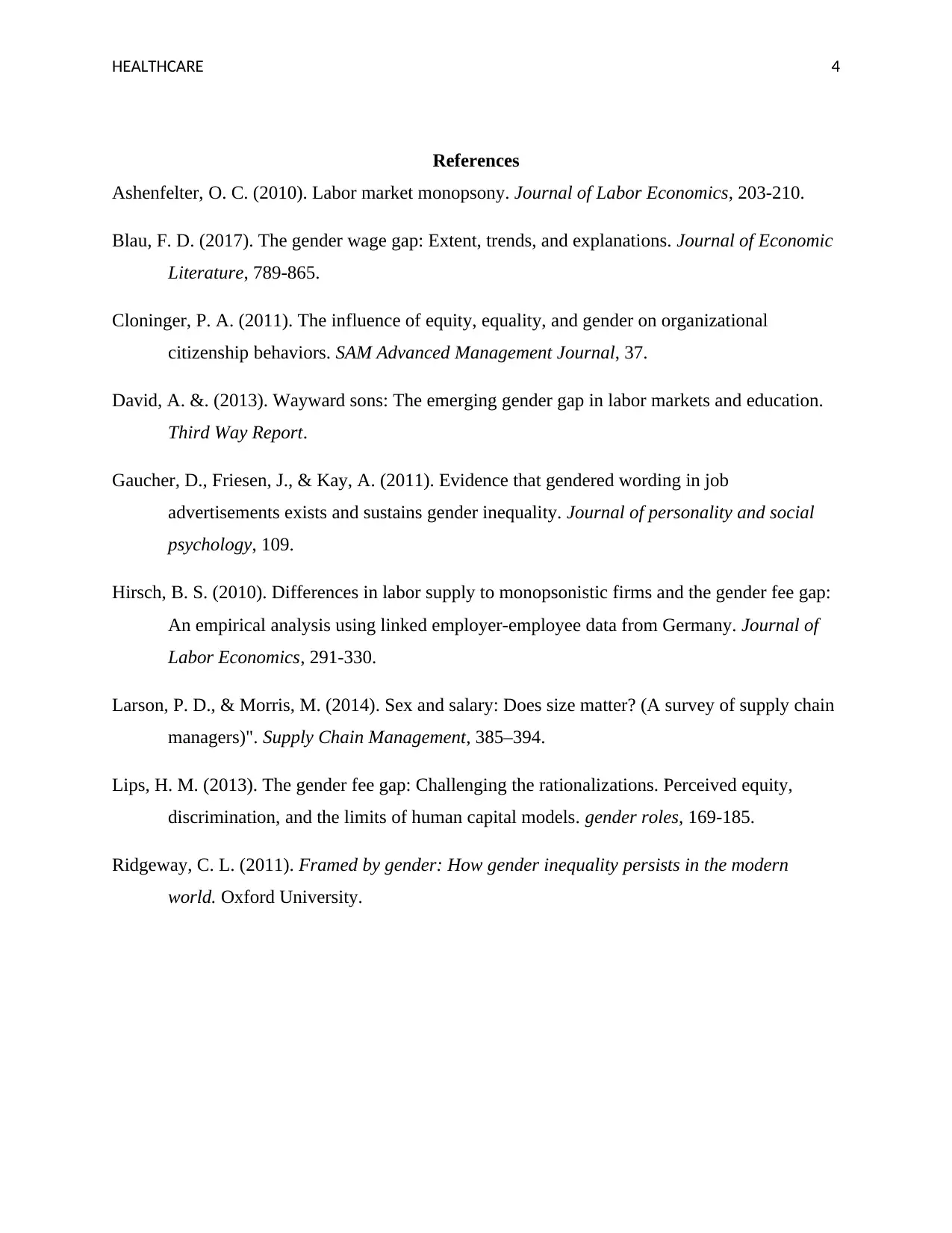
HEALTHCARE 4
References
Ashenfelter, O. C. (2010). Labor market monopsony. Journal of Labor Economics, 203-210.
Blau, F. D. (2017). The gender wage gap: Extent, trends, and explanations. Journal of Economic
Literature, 789-865.
Cloninger, P. A. (2011). The influence of equity, equality, and gender on organizational
citizenship behaviors. SAM Advanced Management Journal, 37.
David, A. &. (2013). Wayward sons: The emerging gender gap in labor markets and education.
Third Way Report.
Gaucher, D., Friesen, J., & Kay, A. (2011). Evidence that gendered wording in job
advertisements exists and sustains gender inequality. Journal of personality and social
psychology, 109.
Hirsch, B. S. (2010). Differences in labor supply to monopsonistic firms and the gender fee gap:
An empirical analysis using linked employer-employee data from Germany. Journal of
Labor Economics, 291-330.
Larson, P. D., & Morris, M. (2014). Sex and salary: Does size matter? (A survey of supply chain
managers)". Supply Chain Management, 385–394.
Lips, H. M. (2013). The gender fee gap: Challenging the rationalizations. Perceived equity,
discrimination, and the limits of human capital models. gender roles, 169-185.
Ridgeway, C. L. (2011). Framed by gender: How gender inequality persists in the modern
world. Oxford University.
References
Ashenfelter, O. C. (2010). Labor market monopsony. Journal of Labor Economics, 203-210.
Blau, F. D. (2017). The gender wage gap: Extent, trends, and explanations. Journal of Economic
Literature, 789-865.
Cloninger, P. A. (2011). The influence of equity, equality, and gender on organizational
citizenship behaviors. SAM Advanced Management Journal, 37.
David, A. &. (2013). Wayward sons: The emerging gender gap in labor markets and education.
Third Way Report.
Gaucher, D., Friesen, J., & Kay, A. (2011). Evidence that gendered wording in job
advertisements exists and sustains gender inequality. Journal of personality and social
psychology, 109.
Hirsch, B. S. (2010). Differences in labor supply to monopsonistic firms and the gender fee gap:
An empirical analysis using linked employer-employee data from Germany. Journal of
Labor Economics, 291-330.
Larson, P. D., & Morris, M. (2014). Sex and salary: Does size matter? (A survey of supply chain
managers)". Supply Chain Management, 385–394.
Lips, H. M. (2013). The gender fee gap: Challenging the rationalizations. Perceived equity,
discrimination, and the limits of human capital models. gender roles, 169-185.
Ridgeway, C. L. (2011). Framed by gender: How gender inequality persists in the modern
world. Oxford University.
1 out of 5
Related Documents
Your All-in-One AI-Powered Toolkit for Academic Success.
+13062052269
info@desklib.com
Available 24*7 on WhatsApp / Email
![[object Object]](/_next/static/media/star-bottom.7253800d.svg)
Unlock your academic potential
Copyright © 2020–2025 A2Z Services. All Rights Reserved. Developed and managed by ZUCOL.




